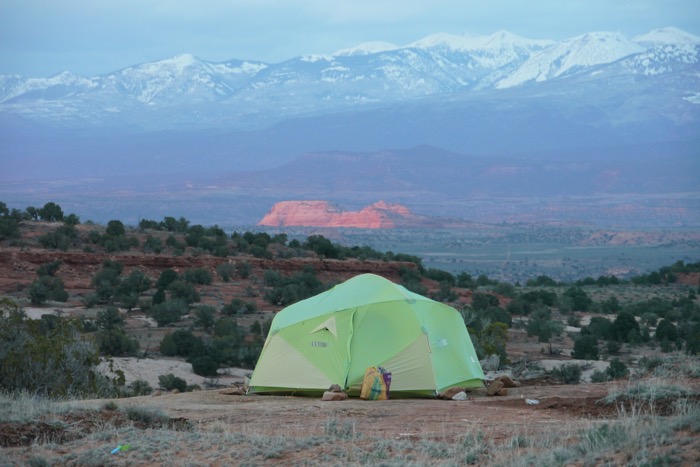Answer: Probably UV resistance is the best place to start: it's very good. Better than nylon by a long shot. In fact if you used both side by side for a couple of weeks the polyester would be significantly stronger than the nylon. Not that most people should care (at least not much). I'll explain:
The PU (polyurethane) on the underside of a sil/pu fabric makes the seams tapeable and that's the norm for US products. The tear strength is going to vary all over the map from source to source but the exact fabric I use in the MoonLights start out roughly about 15% lower strength than ripstop sil/pu nylon from the same company (10% less in the warp direction, 20% less in the fill). But here's the thing: no one actually bases their tear strength requirements or even their desires on what’s NEEDED because no one knows what that too-low number is. So we've gotten into a sort of tear strength arms race even though it's obvious that it's the tensile strength that a tent primarily needs, and all fabrics available are WAY overkill on tensile strength.
Back in the day, I took it upon myself to ask repair departments of my clients (and Kelty, of course, when I was there) what, if any repairs they saw that were caused by the tear strength being too low. Tents age, UV damages fabric, surely there should be some indication of a lower limit to tear strength in use. But the answer was always no. No repairs ever because tear strength was too low. Actually it was quite striking. There were even tents sent in for repair that you could literally push your finger through which weren't being sent back to be fixed because of that; the customer hadn't damaged it and it was sent back for something else entirely!
As to abrasion resistance or puncture resistance, ALL the lightweight fabrics we use are just terrible – it takes the barest swoosh against a sharp rock or a gnarled tree to put a bunch of holes or a tear into a rainfly. About the only thing one can say about higher tear strength is that there's the theoretical possibility (and hope) that a tear won't propagate as much in a higher tear strength fabric. But prevent a tear? No way. This is when having some of the truly excellent repair tapes available can really save the day. I love modern repair tapes. They're so good, even a floor repair with one of the tapes we mention is extremely waterproof. True: I've even used these tapes to repair an actively spurting garden hose - right over the spurt - and it stopped the leak just like that! The stuff is just amazing!
Probably now would be a good time to also mention that the acceptability of any particular tear strength depends on the USER and their expectations — especially as regards the floor. Because the MoonLights are made to be genuine backpacking tents, they use 30D floors which are far LESS prone to accumulating little rips than the 15D* and 20D* nylon fabrics used in the lightest tents available. But the flip side is that our 30D floors, are also MORE prone to accumulating little rips and tears than heavier fabrics like 40D (and heavier). No news there. So the tent feature - being lightweight and compressible - is why user's need to be familiar with those fantastic repair tapes we keep mentioning. This is part and parcel of the current set of tradeoffs of the MoonLight tents. I'll even go as far to say that if these tents never got little rips and tears in them, then it would signal that the fabrics are too heavy. As a backpacker, that's pretty much my attitude on all my fabric based gear.
That said, if I get feedback from MoonLight tent owners that I've misjudged their desires, then I'll change the fabrics. For instance, all 2020 and later tents use 20D netting instead of the 10D we used before. The small extra weight (3 grams per square meter) will reduce the little nick-nard holes and tears that I've seen customers get. It was a small number, but more than I thought I should see. But there's no shortcutting this process.
Here’s a link to McNett’s “Tenacious Tape” under their Gear Aid brand
Here’s a link to Kenyon’s “K-Tape”
But some swear that this is the best one of all: “Tear-Aid Type A”
Hot tip: buy clear or white so the color matches automatically.
Here's a video of an epic repair I did with tape. It's WAY beyond a sewn repair for ease and effectiveness.
Yes, the video is a little long. You must be slow and careful to pull this off.
Side note: reinforcing stress points is absolutely necessary regardless of a fabric's tear strength or it will get ripped in use. Everyone seems to do at least a fair job of this so it's not much of a differentiating feature.
Side side note: The only polyester fabrics, other than our own, that you’re likely to find in tents on the market are 68D and 75D fabrics which are much heavier and bulkier than the 20D and 30D denier fabrics in the MoonLights. That's not so surprising because the 20D fabrics in the MoonLights are THE lightest polyester fabrics that can confidently be used in tents (at this time). You might think that the next thing I’m going to say is something bad about 68D & 75D fabrics, but actually, I think they're terrific. They weigh more, but they're inexpensive and perform way above their price point. You’ll find these fabrics in virtually all major brands’ larger tents and in their value-priced backpacking tents (running around $200 for a 2-person model, give or take). Sadly, polyester is mostly just used in the rainflies, the body and floor are still often nylon. It’s a pity because having the body and floor expand and contract is not good: sometimes the tent can be ridiculously tight setting up and it actually makes the square footage of the floor smaller – up to 7% smaller - than it’s specs say it is. The reason is that since all tents are made in Asia, you can safely assume that they were made in high humidity and therefore all nylon tents were made in their expanded state so they're bigger in all dimensions than when they dry out completely – like in the Rockies or the Sierra, or in the Southwestern US just about everywhere.
_______________
*20D means twenty denier, 30D means 30 denier. Denier is a measure of the weight of the yarn used in a fabric. It's the number of grams that 10,000 yards (or 9,000 meters) of the yarn weighs. It's kind of mind blowing to realize that this means that 5.68 miles of a 20D yarn weighs 20 grams which is .7 ounces (point seven ounces). It doesn't even make sense until you do this calculation: a single square yard of fabric with a yarn count of, say, 500 threads per inch has has 250X36=9,000 yards of yarn** in one weave direction and another 250X36=9,000 yards of yarn** in the other weave direction – thats 18,000 yards of yarn in one square yard of 250 count fabric. For a 20D fabric this means that our square yard weighs about 20x1.8=36 grams/sqyd (43.5 g/sqm). Mind unblown. Chalk up another that-makes-sense-now moment thanks to the power of math (or at least arithmetic)
** Even though the term "thread count" implies that fabrics are made of "threads," the term "yarn" is the more correct term because yarns are the components that fabrics AND threads are made of. Yarns, in turn are made of "filaments." So if you really wanted to describe a fabric you would give the specs like this: 250x250 (thread count), 20D (27f). This tells us that the fabric has a balanced construction with 250 yarns per inch in both weave directions (usually the count is not the same in both directions) and that the 20D yards are composed of 27 filaments (each having a denier of .926).

